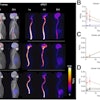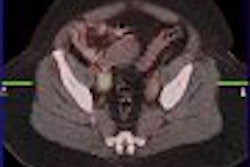With the number of people with Alzheimer's disease and other forms of dementia expected to rise over the next 10 years, researchers are looking for ways to improve diagnostic accuracy and subsequently use the most appropriate therapeutic option on patients.
Past clinical research has shown FDG-PET's ability to increase the diagnosis accuracy of Alzheimer's disease, with sensitivity in the range of 94% and specificity of 73%.
However, there remains "a dearth of literature for multicenter studies that use separate training and testing data for fully automated computer-aided diagnosis," said Jonathan Piper from the department of computer science at Wake Forest University in Winston-Salem, NC, and MIMvista, a Cleveland-based developer of advanced visualization software for nuclear medicine.
During the first annual joint conference of the Academy of Molecular Imaging (AMI) and Society of Molecular Imaging (SMI) in September in Providence, RI, Piper presented results of a study designed to validate an artificial neural network (ANN) computer-aided detection (CAD) scheme for diagnosing Alzheimer's disease with multicenter data.
Statistics generation
The researchers used registration and region-based statistics generated by MIMneuro, an automated PET/SPECT software from MIMvista for quantitative analysis of Alzheimer's, as well as other dementias and neurological disorders. A 3D anatomical brain atlas also is utilized for localization of structures of interest.
FDG-PET images were acquired as part of the Alzheimer's Disease Neuroimaging Initiative (ADNI), using various imaging protocols, reconstructions, and cameras from 36 different imaging centers for 128 subjects. Sixty-one subjects were clinically diagnosed with Alzheimer's, while 67 subjects were normal controls.
Piper noted that the 128 scans came from 36 distinct sites, with "each of those sites having different cameras and acquisition and reconstruction protocols."
Each brain was spatially registered to a common standard template volume to reduce anatomical viability, while region-based statistics were computed using both a single brain atlas and a multisubject probabilistic atlas for anatomic sensitivity and specificity.
"The first atlas was a single brain atlas with 132 volumes of interest defined," Piper explained in his presentation. "The second atlas was a probabilistic atlas, which was ... defined on 10 subjects with 24 volumes of interest." Using the intersection of different numbers of the 10 subjects, different regional sensitivities and specificities were achieved.
Single brain results
Using the single brain atlas only, the selected ANN resulted in 92% sensitivity, 90% specificity, and 91% accuracy. With the addition of the probabilistic atlas, the ANN provided increased predictive power of 93% sensitivity, 95% specificity, and 94% accuracy.
In addition, the results for using "the classifier for the single brain atlas only gave 93% accuracy when fitting the training data and 91% predictive accuracy, with a slight bias toward sensitivity over specificity," Piper said. "When both atlases were considered, the fitting accuracy was 96% and the predictive accuracy for the testing set was 94.5%, with a slight bias toward specificity."
Given those inputs, Piper said it is possible to bias the training algorithm toward highly sensitive or highly specific results. "When you bias toward specificity, you can achieve a 3% increase in specificity to 98%, with a 1.5% decrease in accuracy," he added. "Biasing these inputs toward sensitivity, there is a less than 2% increase in sensitivity with a fairly large 7% decrease in accuracy."
Diagnostic accuracy of 94% could be the highest result reported for Alzheimer's disease using automated diagnosis and FDG-PET from multiple imaging centers, the team noted.
ANN CAD scheme
The researchers concluded that the ANN CAD scheme allows for considerable flexibility during the training stage and could be tuned to increase either sensitivity at the expense of specificity or vice versa. The flexibility of the MIMneuro probabilistic atlas allows for significantly better results than a single brain atlas alone.
"Future directions for the study are to evaluate the subjects that were misclassified and explore some techniques for better input selection," Piper added. "This step was independent from the ANN training step. If we integrate that, perhaps we can get a better classifier."
Additional probabilistic atlas regions would be necessary for more studies, he said. Two of the regions that were used in the single brain atlas -- the left inferior temporal lobe and the precentral gyrus -- will be considered for the probabilistic atlas.
This technique also may be tested on mildly cognitive impaired subjects in the future, when sufficient data is available from the ADNI study, Piper said.
By Wayne Forrest
AuntMinnie.com staff writer
October 2, 2007
Related Reading
FDG-PET can influence Alzheimer's, dementia treatment, September 6, 2007
PET shows promise in atypical dementia evaluation, August 29, 2007
Studies link Alzheimer's to beta-amyloid and potential for new ligand, June 26, 2007
Road to RSNA, MIMvista, November 8, 2006
MIMvista debuts neuro software, June 7, 2006
Copyright © 2007 AuntMinnie.com




















